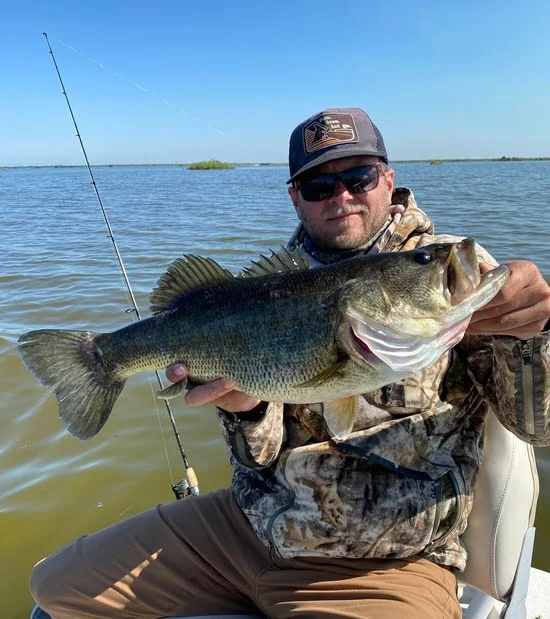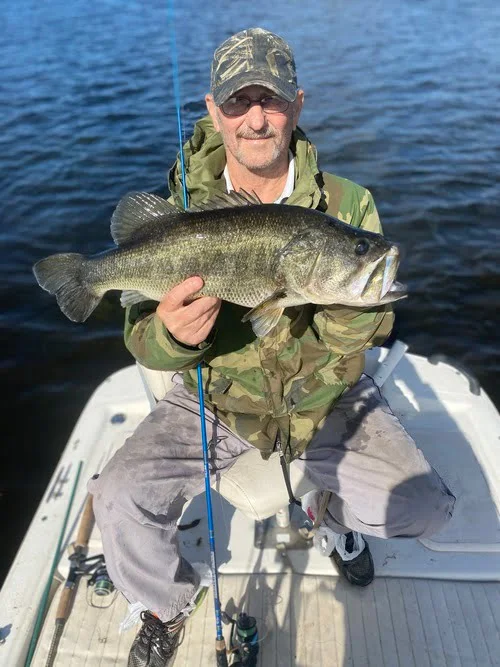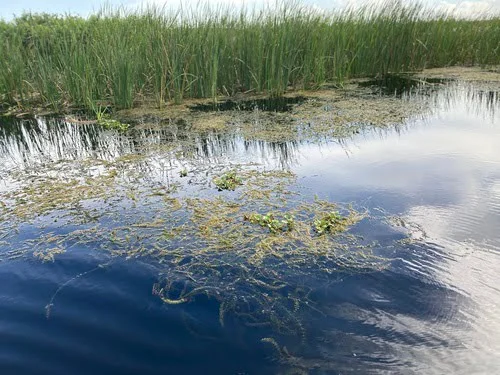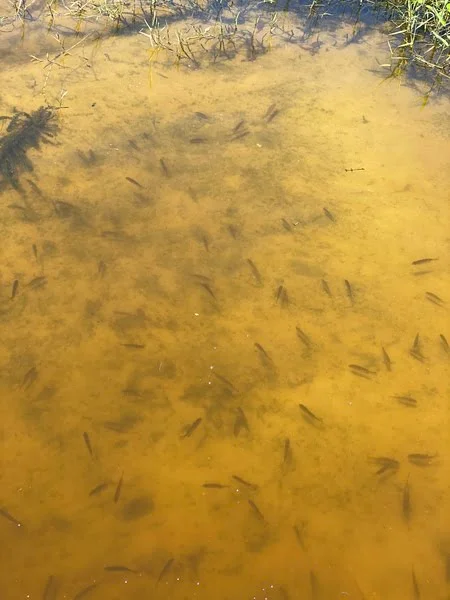During the spring and summer when the sun is shining and the water is warm, bass fishing is at its best.
Not only is it a great time of year, but it’s pleasant outside and a great way to spend time with friends and family.
But what about winter fishing for bass? Is it worth braving frigid temperatures and cloudy days in search of the bite?
And where the heck do all the bass go during the winter anyway?
In this article, i’m going to break it all down…and explain why winter fishing for bass is a great opportunity for the persistent angler.
This page contains affiliate links. As an Amazon Associate, I earn from qualifying purchases.
Table of Contents
Can You Catch Bass in the Winter?
Bass fishing gets tough when the water gets cold, but I assure you, you can catch bass in the winter! That’s because bass still have to feed, even during the coldest times of year.
In the harshest winters, bass fishing will be challenging, but you can still catch them even when water temperatures plummet.

Knowing where to look and which lures to use will greatly improve your success this winter.
About Winter Time Bassin’
Largemouth Bass are cold-blooded animals, and their activity depends on the temperature of their environment. In the winter, fish metabolism slows down, and fish don’t have to eat as much.
When winter temperatures get really cold, and the water freezes over, fish can enter a state of dormancy known as torpor, which can be compared to hibernation but for fish. During this state, bass will often lay motionless to conserve energy.
That’s why, in the coldest winters, the bass get extremely lethargic, and they can be very lazy and picky this time of year. Bass move less and feed less to save energy when it gets really cold.
However, bass still have to feed the winter, and the winter presents a great opportunity to grind it out for some of the biggest bites of the year.
Why Is Winter Bass Fishing Overlooked?
Even though bass fishing is immensely popular In the winter, many anglers also get lazy, and most people stay home and stay warm this time of year.
This is the perfect chance to have the lake entirely to yourself!
Having the lake to yourself can be extremely rare for most of the year, but when the weather gets cold, many people can’t bear the weather.
In the southern states, like Florida, Texas, and Alabama for example, bass fishing in the winters is not nearly as challenging. This time of year bass fishing can be incredibly productive.
Okay, i’m born and raised in central Florida, where winter temperatures average about 50 degrees farenheit, so i might be a little biased, ha!
The bass fishing is quite easy here this time of year because bass feel comfortable in the mild winters, and they feed heavily preparing to spawn in the early spring.
Where Do Bass Go In the Winter?
In the winter, bass seek the most stable water temperatures. This is usually in deeper water where they are less at risk of sudden cold snaps. During this time of year, bass love structure, even more so than they do during the rest of the year.

Structure, whether it be submerged trees, rocks, or grass, helps bass ambush prey. By ambushing and taking their prey by surprise, bass can feed effectively and conserve valuable energy.
This time of year, bass will stay very close to the baitfish. Look for signs of baitfish and there will be bass nearby.
Look for birds feeding on baitfish, like shad, shiners, or silversides. You may see schools of pelagic baitfish near the surface in the morning and evening.
Pelagic baitfish will also stay suspended over deeper water where the temperature and oxygen is stable.
If you’ve ever watched your fish finder while idling over deep water and see those balls of suspended fish? That is most likely bait, hovered over a thermocline where the water temperature is stable.
Where Do Bass Go In the Winter in Ponds and Lakes?
Finding bass in ponds may seem difficult, but it’s actually much simpler than in larger bodies of water. Ponds are easier to break down, cover water, and find fish.
During the coldest part of winter, bass in natural ponds and lakes go to the deepest part of the lake. In most ponds and lakes, this is usually the middle of the lake where a depression forms. This deeper water has the most stable temperature, so fish feel comfortable here.
This is true for shallow and deeper lakes. In the deepest lakes or in lakes with dams, bass might sit on the deep water transition.
In very large lakes and reservoirs that are extremely deep, bass isn’t usually on the bottom. Instead, they will usually be suspended at around 20 to 40 feet deep.
The bottom of these deep lakes can be extremely oxygen poor during the winter, so most fish will not stay that deep.
You May Also Like: Why Does My Pond Only Have Small Bass? Here’s Why!
Where Do Bass Go In the Winter in Rivers?
The current in natural rivers adds another challenge for bass fishing during the winter. Fortunately, bass can be somewhat predictable this time of year.
Moving water is a challenge for the bass too, so in rivers, bass will do their best to get out of the current and save energy. Swimming in the current is exhausting, and in the winter their energy is limited.
They look for areas in the river to get out of moving water as much as possible.
During the winter, river bass will tuck up into the structure as much as possible, especially if it blocks some current and swift water. If your river has oxbows or stagnant pools, bass will go here during the winter.
The edges of river bends are also great places to find bass in the winter. Deep water will also help bass get out of the current.
Deep holes in rivers provide the structure for bass to escape current and the stable temperatures for bass to feel comfortable during the winter.

Weather Patterns for Winter Largemouth Bass Fishing
Fishing is generally best a day or two before a cold front, and during the winter this is especially true. Sudden cold snaps raise the barometric pressure and fish become uncomfortable and unwilling to feed.
That’s why the warmest days before a cold front are going to be your best chance during the winter.
See Also: Fishing After Rain- Is It Worth It Or A Waste Of Time?
Sunny days can help to raise the water temperature a bit, especially in shallow water habitats, and fish can temporarily become more active. On these sunny days, you may see bass move up shallow to warm up in the sun.
Use this to your advantage and you have a good chance at success bass fishing this winter.
Bass Fishing the Winter to Spring Transition
Towards the end of winter, and as temperatures start to get warmer, bass will begin to transition to springtime patterns and start showing pre-spawn behavior.
This is one of your best chances all year at a giant bass!
The big female bass will be getting their energy reserves stored up for the rigorous spawn season ahead.
This time of year can be very unpredictable. Weather changes, like a strong cold front, for example, can make fish lazy again. Those warm days before a cold front will be your best bet for bass fishing.
Bass will move around a lot this time of year. Bass are moving from their deep winter refuge to the backs of bays, creek mouths, and other shallow habitats.
During this transition, bass will stop along the way to stay on structure to feed and replenish their energy.
Covering water is most effective during this transitional period. If you have side imaging technology, this will help you significantly. Reaction baits, like spinnerbaits, jerk baits, and lipless crank baits are ideal during this transitional time.
What Do Bass Eat in the Winter?
The diet of largemouth bass is quite varied, even in the winter. Naturally, they are opportunistic and will eat whatever prey is vulnerable to them.

In the winter, shad and shiners begin to slow down due to the cold, and sometimes they even start to die off from the cold. Bass feed on these weakened baitfish during the winter. Bass also feed heavily on crayfish this time of year.
Big slow moving prey, like a weakened gizzard shad is hard to pass up for a bass.
If they can catch a high energy meal without expending too much energy chasing it down, they will surely eat it right up. Slow moving bait is a key pattern for bass fishing in the winter.
Best Lures For Winter Bass Fishing
For winter bass fishing, you want to focus on lures that resemble an injured or lethargic baitfish. These can be finesse lures, or lure varieties that allow for a long pause and slow fishing cadence.
Here are my favorites:
Ned Rig
The Ned rig is one of the best finesse lures for bass fishing, and it works great during the winter.

The Ned rig has a flat mushroom-style jig head and a short stubby soft plastic, usually 3 inches long. This rig should be worked very slowly along the bottom, even deadsticked, to entice a lazy winter bass.
I like to use Z-Man Finesse TRD on a 1/8 to 1/4 oz mushroom style jig head. Choosing colors is very simple.
I like to use browns, blacks, and greens to imitate crawfish, and natural baitfish colors also work to imitate a dying shad struggling along the bottom.
Jerk bait
A suspending jerk bait is another great option during the winter. It can be fished aggressively and then comes to a sudden stop in the middle of the water column.

This can trigger a reaction bite from winter bass, and it works especially well in clearer water.
Choose a jerk bait depending on the depth you are fishing. Different sizes dive to different depths. I like the Rapala Rip Stop because this lure comes to an instant stop after the twitch.
The jerk bait has the unique ability to get bites even when fish aren’t interested in eating. The jerk bait has an aggressive action that takes advantage of the feeding reactions and instincts in all bass.
Jig
Thanks to its weed guard, a bass jig is a perfect option for flipping into deep structures, and it works especially well in deeper lakes and rivers. Fish a jig slowly on the bottom, similar to a ned rig.

Several styles and brands of jigs will work. I like to use a flipping jig, and the color, weight, and trailers depend on the water depth and color.
A Yamamoto double tail grub trailer is a great all around jig trailer.
Blade Bait
A metal blade bait is similar to a lipless crankbait, but it is an all metal design. This bait does a great job at imitating an injured shad or shiner, especially from a vertical position like a boat or pier.

Fish the blade bait by hopping it along the bottom with a slow jigging motion. Or give it an aggressive popping action, and then let it fall slowly before popping again.
Conclusion
If you can brave the weather elements during winter, and follow the tips presented in this article, you too can have success winter fishing for bass.
So throw on an extra layer, bring a thermos of hot coffee and hit the lake…chances are you’ll have it to yourself and with a little work, the bass will bite.
You May Also Like: Carp vs Bass: Friendly Duo Or Harmful To Fishing?
If you haven’t guessed yet, I love fishing and everything about it!
To learn more about why I started Panfish Nation, visit the About page and follow along on Social Media:


Download a copy of my FREE Lure Color Selection Chart & Knot Guide!
Stay up to date with fishing reports, tackle reviews, industry news, and much more! We respect your privacy, unsubscribe at any time.
